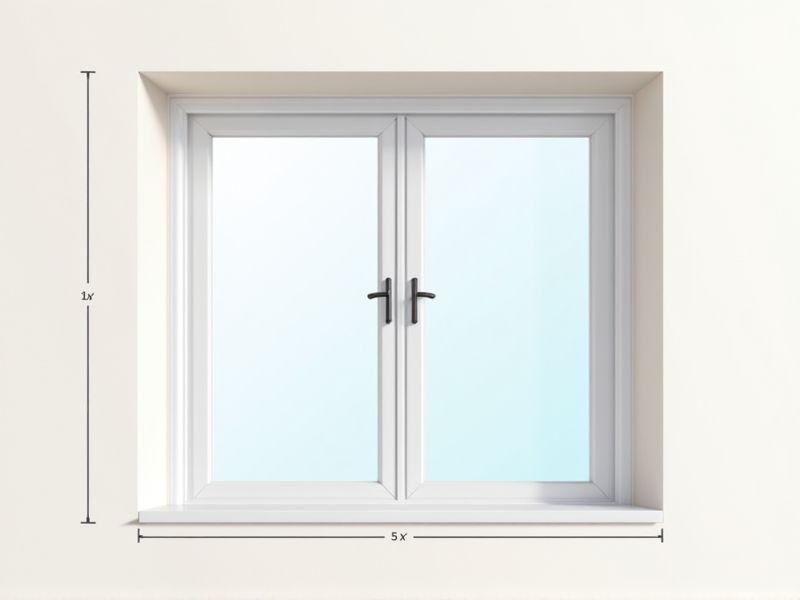
House window dimensions can vary depending on style, room function, and architectural design, but there are commonly used standard sizes that simplify both selection and installation. For example, single-hung and double-hung windows often come in widths of 24, 28, 32, and 36 inches, with heights ranging from 36 to 72 inches, increasing in increments of 6 inches. Casement and sliding windows may have similar width options, but often allow for wider designs. Understanding these standard sizes can help homeowners choose windows that are readily available and reduce customization costs.
Energy Efficiency Considerations
Energy-efficient house windows can reduce heat loss by up to 30%, significantly lowering your heating and cooling costs. Double or triple-glazed windows, which contain insulating gas between panes, offer better thermal performance and can achieve an R-value of 3.0 to 7.0 depending on the type. Low-emissivity (Low-E) coatings can further enhance energy efficiency by reflecting heat back into your home during winter and keeping it out in summer. By selecting Energy Star-rated windows, you not only improve your comfort but also contribute to a reduction in greenhouse gas emissions, promoting a more sustainable environment.
Building Codes Compliance
Building codes dictate that residential windows must meet specific energy efficiency standards, typically achieving a minimum U-factor of 0.30 for insulation. Local codes may also enforce safety standards, requiring tempered or laminated glass in areas near doors or low-to-the-ground windows, mitigating potential hazards. Additionally, the installation height and operability must comply; windows should be accessible and easy to open, especially for emergency egress in bedrooms. Ensuring your home's windows adhere to these regulations not only contributes to safety but can also enhance energy savings by reducing heating and cooling costs.
Ventilation Optimization
House windows play a crucial role in optimizing ventilation, significantly impacting indoor air quality and energy efficiency. Properly designed windows can enhance airflow, with operable units such as casement or sliding windows allowing for effective cross-ventilation. Studies show that homes with strategically placed windows can reduce reliance on HVAC systems by up to 30%, leading to substantial energy savings. To ensure maximum performance, consider window placement and size; ideally, windows should represent at least 10% of the floor area to foster a balanced airflow.
Natural Light Maximization
House windows should be strategically designed to maximize natural light, enhancing both aesthetics and energy efficiency. In a well-optimized design, the window-to-wall ratio typically ranges from 15% to 20%, allowing ample sunlight while maintaining structural integrity. Choosing materials like low-E glass can improve insulation, ensuring that your home remains comfortable year-round while reducing energy costs by up to 30%. Implementing features such as transoms or clerestory windows can further increase light penetration, creating brighter, more inviting spaces.
Aesthetic Proportion
Aesthetic proportion is a crucial factor in the design of house windows, influencing both the visual appeal and functionality of a home. Typically, the ideal window dimensions follow the golden ratio, approximately 1:1.618, which can enhance the overall balance and harmony of a building's facade. Integrating this ratio not only elevates the architectural style but also ensures optimal natural light infiltration, creating brighter living spaces. For your home design, considering these proportions can significantly impact its perceived value and comfort.
Privacy And Security
Choosing windows for your home that emphasize privacy and security is essential for creating a safe and serene living environment. Consider installing double-glazed windows, which provide enhanced insulation and reduce outside noise while making your home less visible from the street. Windows with reinforced glass panes or laminated security glass can resist breakage, adding an extra layer of protection against potential intruders. You should also explore window treatments, such as frosted or tinted glass, to maintain privacy without sacrificing natural light.
Material Durability
The durability of house windows is heavily influenced by the materials used in their construction, with options like vinyl, fiberglass, and aluminum each offering unique benefits. Vinyl windows are praised for their low maintenance and resistance to warping, making them a popular choice for homeowners, while fiberglass provides exceptional insulation, reducing energy costs by up to 30%. On the other hand, aluminum frames, though less insulated, are valued for their strength and longevity, often lasting over 20 years with minimal wear. When selecting windows, consider factors such as energy efficiency ratings (U-factor and Solar Heat Gain Coefficient) to ensure the best choice for your home's durability and performance.
Safety And Egress Requirements
House windows must meet stringent safety and egress standards to ensure occupant safety and ease of escape in emergencies. For instance, a window must have a minimum opening size of 5.7 square feet to allow for a quick exit, while the lowest part of the opening should be no more than 44 inches from the floor. Furthermore, tempered glass is often recommended, as it is designed to shatter safely, minimizing the risk of injury. Compliance with local building codes is essential for ensuring your windows not only enhance safety but also provide a reliable means of exit.
Installation Ease
House windows designed for easy installation typically feature a pre-assembled frame system that allows for rapid setup, reducing labor costs and time. Many models come with a universal sizing option, accommodating standard openings of 24 x 36 inches or 36 x 48 inches, which simplifies the fitting process. Innovative designs, such as tilt-in sashes for cleaning and enhanced weather stripping, ensure not only ease of installation but also improved energy efficiency. As a homeowner, maximizing both convenience and long-term performance is crucial when selecting your windows.
Cost-Effectiveness
The average cost of standard house windows ranges from $300 to $1,000 per window, depending on materials and energy efficiency ratings. Energy-efficient windows can reduce your energy bills by up to 15%, making them a cost-effective long-term investment. Lifetime warranties often accompany these windows, providing peace of mind and potential savings on replacement costs. Selecting double-glazed options may ensure better insulation, further enhancing overall cost-effectiveness.
